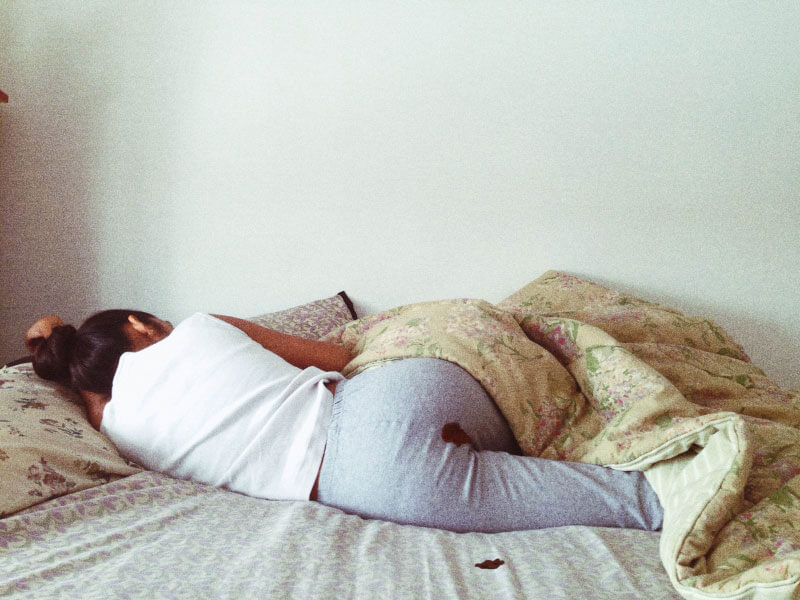In 2015, Insta-poet Rupi Kaur posted a series of fragmented photographs on Instagram representing the honest, bloody reality of menstruation. In them, we see a woman curled in bed, blood staining the sheets and the back of her sweatpants, a heating pad pressed to her abdomen, in the shower as blood orbits the drain, on the toilet, throwing away a used pad, her subsequent bloody toilet water, and, finally, her blood-stained sheets slumping out of an open washing machine. The series evokes an embodied, shared knowledge in period-having people; we know those everyday moments as intimately and corporeally as Kaur does; their soft, familiar textures, their tone of simultaneous surprise and routine. We feel them.

The series was infamously taken down by Instagram, causing an outpouring of feminist response, critiquing Instagram’s unwillingness to portray the universal realities of menstruating women, a move that reads as misogynistic, given the proliferation of sexist images on the social media platform. Ultimately, Instagram apologised and restored the images to Kaur’s account, which is currently followed by approximately 3 million people.
In the wake of that media controversy, it seemed like 2015 would perhaps be the year that pop culture would finally confront and tell narratives that normalised monthly menstruation. NPR even called 2015 “the year of the period” and Cosmo agreed. And yet, the personal narratives didn’t really manifest — at least in pop culture. Yes, we got the #PeriodsAreNotAnInsult hashtag, Kiran Ghandi running the London Marathon freely bleeding, Thinx, and the Diva Cup — but no media as real and penetrating and ordinary as Kaur’s photo series.

Then again, two years later, media outlets heaped praise on the television shows of 2017, proclaiming it the year that made the period public. Yet, in celebrating these mentions, they seem to miss that, in these shows, menstruation has only one pitch: urgent, singular, high-stakes. They show us the period as the exception, instead of as the everyday. These narratives pinpoint menstruation to its apexes, beginning with the onslaught of puberty, as shown by Black-ish when Diane gets her period, her parents call her “more dangerous than usual” — a tired, sexist claim. Rainbow provides an overly anatomical lesson plan about puberty, and we watch generations of mothers passionately explain this rite of passage to their daughters in hyperbolic character.
We see periods show up unannounced in mainstream media’s bedrooms — another climactic, dramatic trope. Women are relieved or concerned; men are horrified, as with the concluding scene in Jill Soloway’s mini-series I Love Dick, where the protagonist obsesses over an infatuation with Dick, only to have their much-lusted-after sexual experience shattered by her sudden period. Season one of Netflix’s 2017 show Glow includes a post-period-sex scene that pivots to a break-up, opening up the conversation for the group of female wrestlers to discuss their bleeding, which prompts the protagonist to suddenly realise she’s late. These are, however, certainly improvements in comparison to earlier shows such as Sex and the City — a show that thrived on making the private public, especially as it relates to women and their bodies, but in which periods are only mentioned very sporadically. Such as when Carrie is late, when Samantha worries she’s starting menopause, in the middle of unfulfilling sex, or when Charlotte’s pedigree dog gets a period. And, in ten years of Friends, a show that emphasised the everyday relational dynamics between men and women, menstruation was only mentioned once: when Chandler and Monica are figuring out when to get pregnant.
Of course, it’s important that we’re offered stories relating periods to pregnancy, but the media’s connections between the two elevate the cultural narrative of menstruation to singularly high-pressure situations, thereby rendering invisible the periodic experience of pain, self-care, and management.
Similarly, during the opening episode of the fifth season of Orange Is the New Black (2017), as the prison erupts into a riot, an inmate reaches into her pants to paint her period blood across her cheek, hoping to get an officer’s attention. This show satirises the period as a mode of disruption and upheaval; the gimmicky, visceral nature of this instance does little to provide a counter-narrative that is realistic, or conveys the daily struggles of people who cannot get pads or tampons while behind bars. Why are we celebrating these on-air moments as progress? It’s 2018. On any given day, approximately 800 million people on this planet are menstruating. Where are the casual, everyday moments of women having their periods? Where are the truer, lived realities of life as a bleeding person: the messiness, the cost, the hormonal changes and pain that has to be dealt with quietly at work and at school?
We know that pop culture has a lot to reverse, given that 1985 was the first year the word period even appeared on mainstream television. Period commercials and advertisements continue to proliferate messages that make it seem shameful. We are still taught that periods are unmentionable and disgusting. But in this moment of nuanced, real, personal and powerful television that has given us Atlanta, The Bisexual, and Insecure, why can’t the menstruation narrative be updated?
Creators might want to look towards literature as a model. Two non-fiction books, both published this year, add nuance and depth to period narratives, showcasing and normalising untold stories instead of perpetuating mainstream media’s high-stakes menstrual dramas. They point us to two places where the period narrative could be further explored in pop culture.
First, MacMillan’s Period: Twelve Voices Tell the Bloody Truth, a young adult collection, offers compelling, personal narratives that deal with periods throughout a lifetime: friends emailing about their monthlies, an author unpacking why black women may be more likely to get their periods early, a trans man describing what it’s like to have his period, and the college student who “freed” the feminine products on her campus with a bobby pin. What would it look like for these true stories to be told on television, portraying periods as communal and liberating, as bonding experiences?
If television can first tackle the subtlety of those stories, then perhaps it can dive next into the deeper territory of oppression. Anna Dahlqvist’s It’s Only Blood: Shattering the Taboo of Menstruation asks, “What happens when menstrual shame clashes with poverty?” Dahlqvist shares interviews with women in Uganda, Kenya, Bangladesh and India, and the result is stories that upend any western sense of struggle, bringing us deeper into a scarier, universal silencing. When young women cannot afford disposable products and do not have toilets with running water, they are left to use and reuse cloth, washing it, disrupting their daily lives in schools and factories. Reading the harrowing accounts in the book shows that menstrual care is a right, an act of dignity, and that the current stakes for menstruating people in poverty are dire.
Both books expand our understanding of what menstruation is, allowing us to broadly conceptualise the experience of women globally, while also getting close-up accounts of the pain and shame certain individuals face. Hopefully the next step will be having these stories translated from the page to the screen, bringing a much-needed lens for showcasing more authentic menstrual narratives to the media.
